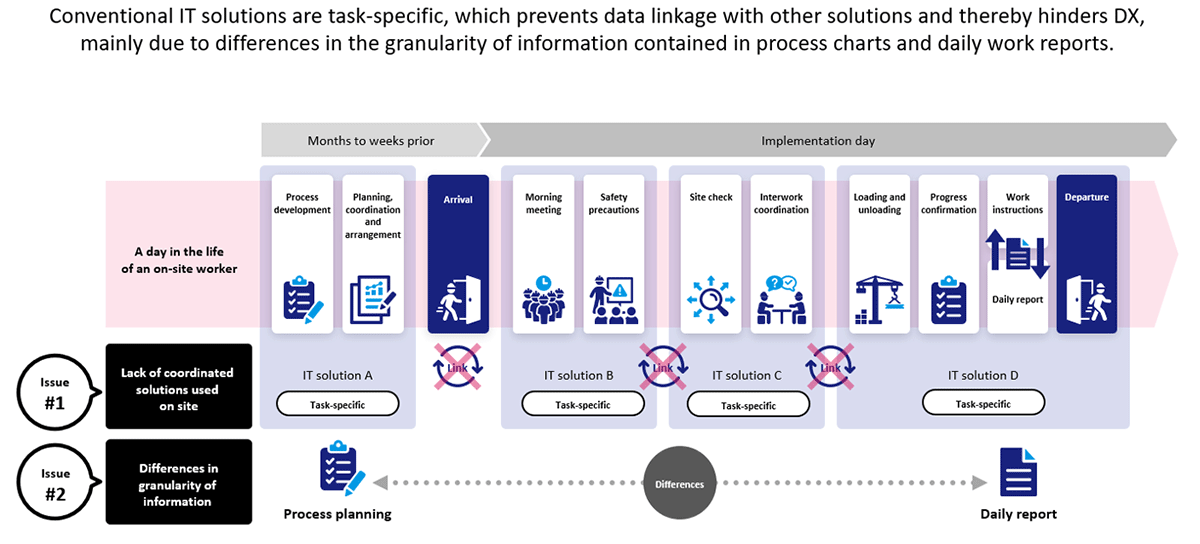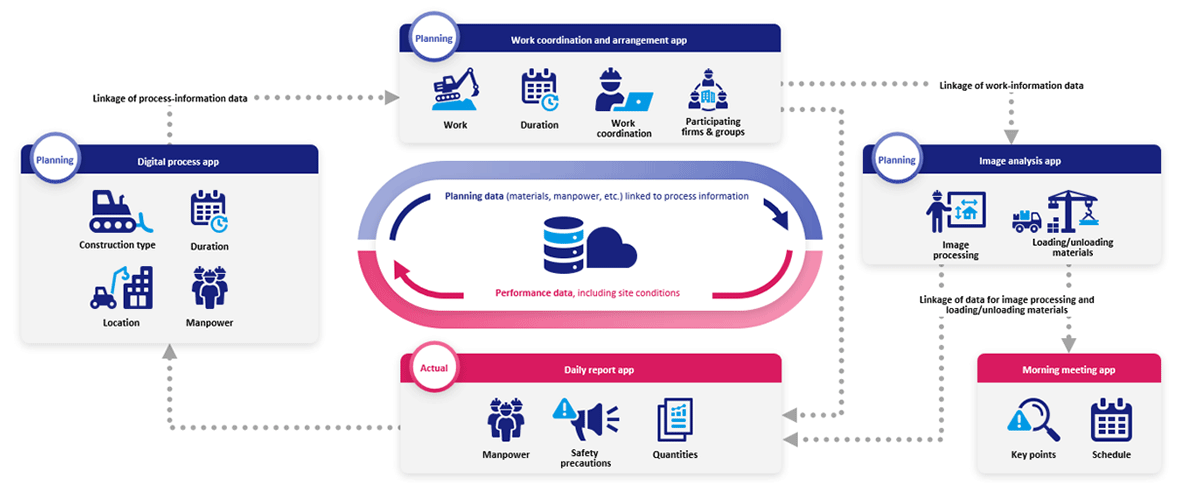July 11, 2023
NTT Communications Corporation
Takenaka Corporation
Shimizu Corporation
NTT Com, Takenaka and Shimizu to collaborate on digital transformation of construction sites
TOKYO, JAPAN, July 11, 2023—NTT Communications Corporation (NTT Com), Takenaka Corporation and Shimizu Corporation announced today that they will collaborate on the digital transformation (DX) of construction sites, aiming to improve the productivity of construction management operations by digitalizing and linking information used for process management, material logistics, work instructions, etc., in process charts and daily work reports. The three companies had been exploring such solutions independently, so their collaboration is expected to accelerate the development and commercialization of DX solutions for construction sites.
IT solutions for construction management conventionally are specialized for individual tasks, making it difficult to link data used for different solutions. The main problem is differences in data granularity, or the degrees and methods of detailing data sets that underly the information contained in process charts and daily work reports. This has also been the key obstacle to achieving digital transformation. In response, the collaboration will focus on developing a logic system to link data by harmonizing differences in information.
Digital transformation of construction management

The collaboration is expected to help advance the digital transformation of construction management in three main areas:
1. Improving productivity through data linkage
Data from process charts will be applied to material logistics, work instructions and daily work reports, thereby eliminating duplicate entries and transcription errors. Linkage of labor, materials, space and equipment data will improve the accuracy of process planning. Also, the partners expect to develop a construction-management system that semi-automates process charting, material logistics, work instructions and more.
2. Accumulating process-related data
Data accumulated in various solutions will make it possible to visualize productivity indices for materials and processes. Furthermore, such data is expected to facilitate the realization of technologies that are still being explored, such as process simulation, 4D BIM,* automatic generation of process charts, and construction robot coordination.
*Building information modeling (BIM), a three-dimensional digital model of a building, to which a time axis is added.
3. Standardizing process information
The construction industry has made progress in standardizing data in areas such as BIM, but process and work information have yet to be standardized, so the collaboration is expected to accelerate progress in this area.
As for the roles of each company, NTT Com will provide learnings from digital-transformation cases in other industries as well as information and telecommunications know-how and expertise. NTT Com will also be in charge of designing the agile construction of a communication system for on-site use. Takenaka will provide knowledge and expertise on construction sites as well as implement test initiatives at its own construction sites. Shimizu’s role will be similar to that of Takenaka, and will also include coordination with a Japan Federation of Construction Contractors program that is used to calculate construction durations.
The three companies will set up a working group to develop, establish and implement digital transformation solutions at construction sites. Once specific solutions are refined through practical testing by Takenaka and Shimizu, NTT Com plans to provide various digital-transformation services to the construction industry. The collaboration is expected to revolutionize processes used throughout the construction industry as well as support increased productivity and advance the reform of workstyles. The three companies will also seek to create new value in various ways by leveraging the data that they expect to generate through their collaboration.
In recent years, the Japanese construction industry has faced challenges such as overtime caps, a declining and aging workforce, and an urgent need to improve overall construction productivity through digital transformation. Buildings are conventionally constructed according to schedules determined using process charts. Digital transformation is progressing in the use of BIM to create building plans, but the management of process information is still very analog, so digital-transformation progress has been limited overall. Since process management is the core of construction management and affects all workers on job sites, digital transformation is expected to have a very significant impact on productivity improvement in the construction industry.
For more information (media inquiries):
Public Relations, Corporate Planning
Tel: +81-3-6810-5140
Construction Planning Office, General Construction Division
kenkikaku-mlist@shimz.co.jp
Attachment:
Using DX to manage construction operations

1. Various attribute information (work type, work volume, manpower, etc.) of processes is added to the information in a schedule.
2. Information in the schedule is broken down by work level, necessary granularity (subcontractors, work location, etc.) is added, and interrelated work is coordinated.
3. Work is visualized by adding information on planar locations and arrangements related to adjusted work.
4. Create agendas for morning meetings based on planar-visualized information.
5. Acquire performance data from daily work reports to compare and manage schedules and performance.
2023-R066

 EN
EN

